Natures’ Peak Performances - Worlds' biggest living Organisms
Amazing Organisms
For the sequel of my post series on the 'Ultras' of our marvellous Earth, I want to deal with the biggest organisms growing or wandering on this planet. Again, this is a non-comprehensive list of selected, various organisms from the animal and plant kingdoms, which show some kind of extraordinary characteristic in terms of their size, or weight:
First example: Antarctic Squid
The Antartic squid (Mesonychoteuthis hamiltoni) is also called the colossal squid, because it is considered the heaviest squid species. It is known only from a few specimens that have been spotted and it is believed that it can grow up to 14 m in length and 750 kg in weight.

Image Source: MarineBio
The phenomenon of deep-sea gigantism can be applied to this animal. This is a hypothesis that assumes that comparable taxa or fauna of the deep sea grow larger with increasing water depth.
Furthermore, the colossal squid has the largest known eyes in the entire animal kingdom. The diameter of the eyes is estimated at around 30-40 cm!
Second example: Blue Whale
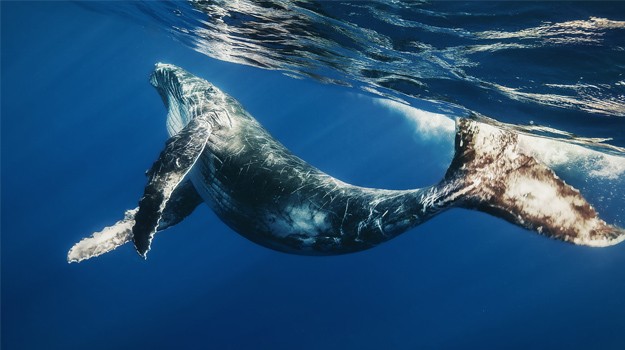
Image Source: Geek.com
With a body length of up to 33 meters and a body mass of up to 200 tons, the blue whale, or Balaenoptera musculus, is the biggest known animal to ever have lived. This species is a cosmopolitan, as it can be found in all oceans of the earth.
Their diet consists almost exclusively of small crustaceans known as krill. In times of whaling, their numbers have been greatly decimated, but after extensive protective measures and regulations, their population was able to recover significantly.
Third example: California redwood
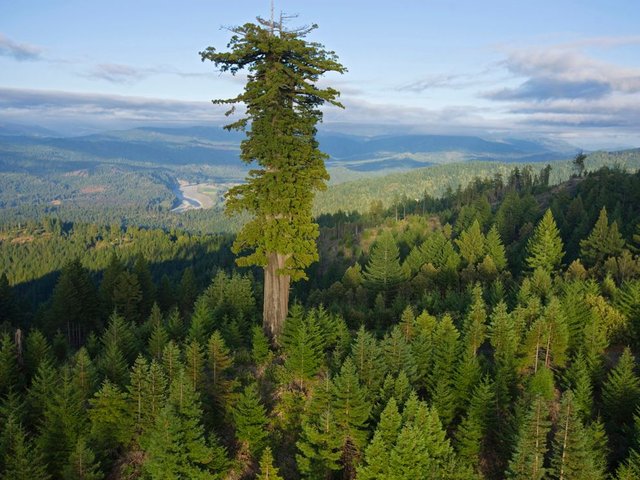
Image Source: National Geographic
However, the title for the tallest land organism goes unchallenged to the tree species Sequoia sempervirens or better known as California redwood. They are well-known for their enormous size and grow easily to a height of about 90 m. But some individuals top that and grow a lot further.
Traditionally these individuals, once found, are given strong names. The largest specimens are known as:
- Hyperion (115.7 m)
- Helios (114.1 m)
- Icarus (113.1 m)
- Paradox (113.0 m)
- Daedalus (110.8 m)
However, Hyperion could already lose its title as the tallest tree in the world in 2031 to its competitor called Paradox, which also grows in California. Since 2006, Paradox showed an annual growth of 18.9 cm, while Hyperion grows only 3.9 cm per year.
To protect them, the one who know are careful not to reveal exact locations.
Fourth example: Populus tremuloides
Now let's take a look at the heaviest organism in the world! It is called 'Pando' or sometimes also 'The Trembling Giant' and is a clonal colony of a single male quaking aspen. It weighs about 6,000 tons!
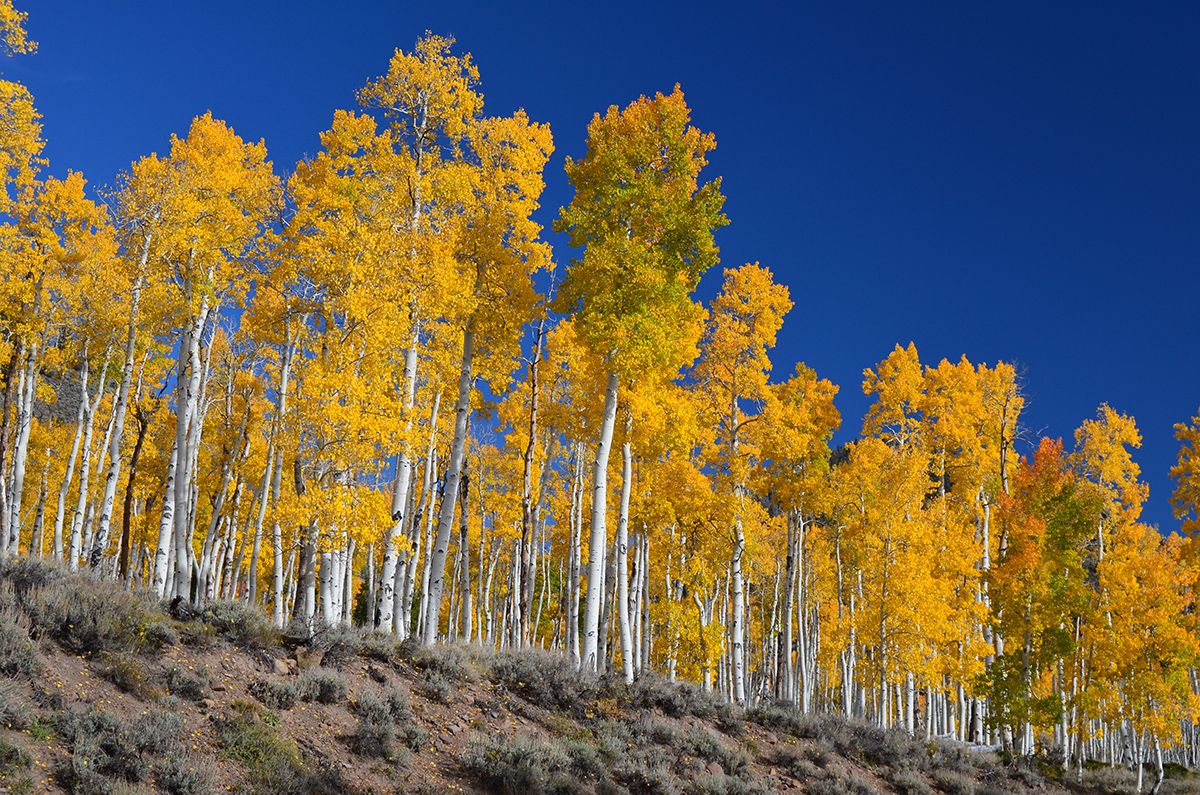
'Pando'
Image Source: J. Zapell
This tree has an incredible subterranean root system out of which roughly 47,000 complete tree stems are growing. The catch, however, is that they are all connected and identified by genetic markers as belonging to only one huge organism. Hence it spans an area of more then 100 acres and can be referred to as the 'Forest of one Tree'.
Pando is located at the western edge of the Colorado Plateau in south-central Utah, United States. The determination of the age of this quiet monster is difficult because the individual tree trunks only get about 100 to 150 years old. The root system and the organism as a whole continue to live on. But due to the average growth and propagation velocity of this species the age of this tree is estimated with about 80,000 years.
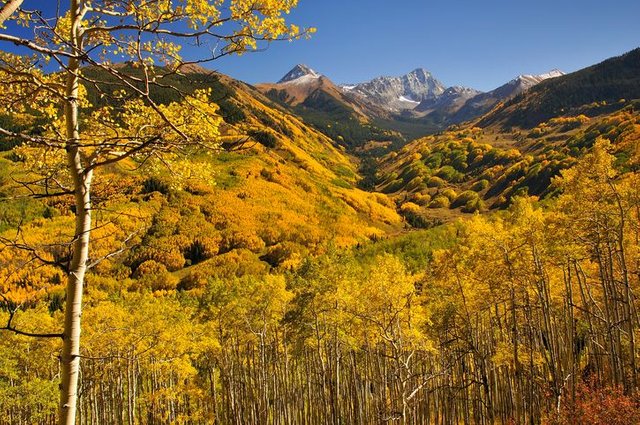
'Pando'
Image Source: Nelson Tree Specialist
There are various reasons for why this tree could reach such enormous proportions. Probably the strongest advantage was brought by frequent forest fires. These prevented the growth of other competitors, such as conifers, while Pando always survived the fires in the underground.
Unfortunately Pando is currently thought to be dying. Scientists are studying the tree, its climate and other factors to find the reason in order to save it.
Fifth example: Honey Mushroom
However, the largest living organism not in terms of its weight but on its extent is a fungus. It is popularly known as the Honey mushroom, or Armillaria ostoyae which is a species of plant pathogenic fungus.
Similar to the example mentioned above, it has an stunning extensive subterraneous network of mushroom mycelium, which forms fruiting bodies at various points. It grows on an area of 900 hectares!
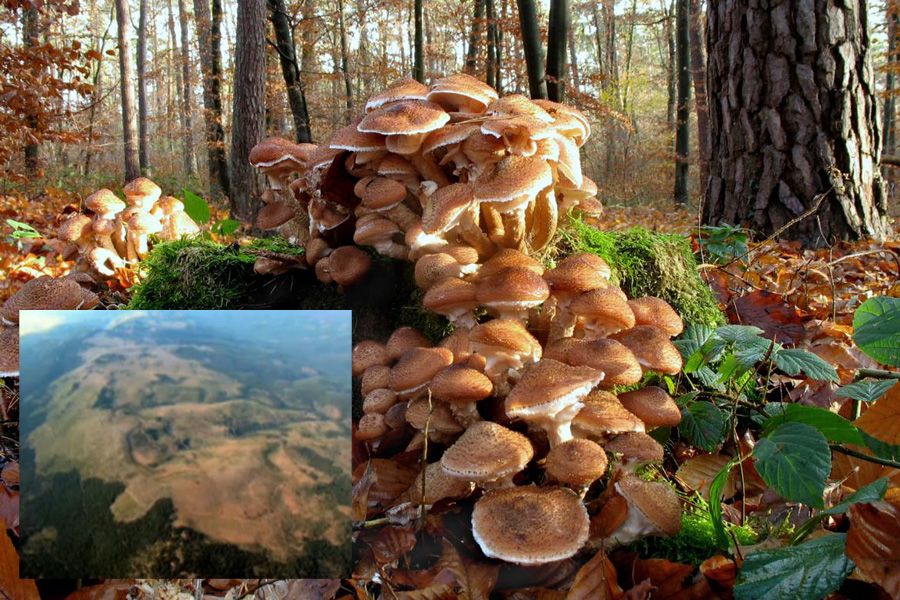
Worlds' largest living organism and its occupied area.
Image Source: blogspot
The gigantic extent of this honey mushroom is explained by researchers with the dry climate in eastern Oregon. Mushrooms can basically reproduce sexually or propagate vegetatively. Due to the climatic conditions, there was little chance of reproducing sexually via spores.
Thus, the old individuals have had little competition and continued to grow and spread undisturbed. The researchers estimate that the record mushroom is at least 2,400 years old.
Further examples of living beings with outstanding dimensions are:
Giraffe:
It is the highest land-living animal and the largest ruminant in the world. The largest ever seen giraffe was a male with a size of 5.88 m.African Elephant:
With a weight of up to 7.5 t (male), they are the heaviest land mammals in the world. The largest specimen was 4.2 m tall and 10.2 m long.Saltwater Crocodile:
The largest recorded saltwater crocodile was 6.3 m long. However, based on crocodile skulls it is assumed that there have already been specimens with a length of 7 m.Southern Elephant Seal:
The males of this species are up to five times heavier than the females. The record holder measured 6.85 m and weighed about 5 tons.Green Anaconda:
Historical records state individual specimens with lengths of up to 8 m. However, this information should be treated with caution, since the determination of the length of these animals is extremely difficult and they grow throughout their whole life.North Pacific Right Whale:
These huge animals can reach an astonishing length of 19.8 m and a weight of about 100,000 kg. Only a few hundred of these species are still alive, making them an endangered species.

Source: pixabay
mountain.phil28
References:
- J. DeWoody, et al. “Pando” Lives: Molecular Genetic Evidence of a Giant Aspen Clone in Central Utah Western North American Naturalist, 2008, 68(4): pp. 493-497
- B. A. Ferguson, et al. Can. J. For. Res., 2003, 33 (4): pp. 612-623
- WLP, Strange but True: The World’s Largest Organism is a Giant Mushroom Book of Research, 2015
- E. Howell, What Is the World's Tallest Tree? LIVESCIENCE, 2013
- World’s Oldest Elephant, 86, Is Dead. In: New York Times, 2003
- R. M. Nowak, (1999). Giraffe, in Walker's Mammals of the World. Volume 1. The Johns Hopkins University Press, pp. 1086–1089
- "Colossal Squid, Mesonychoteuthis hamiltoni ~ MarineBio.org." MarineBio Conservation Society. Web. Accessed Thursday, February 01, 2018. Last update: 1/14/2013 2:22:00 PM ~ Contributor(s): MarineBio
- A. R. C. Britton, et al. "Here be a Dragon: Exceptional Size in Saltwater Crocodile (Crocodylus porosus) from the Philippines". Herpetological Review. 2012) 43 (4): pp. 541–546.
- M. Carwardine, (2008). Animal Records. New York: Sterling. p. 61.
- G. Wood, (1983). The Guinness Book of Animal Facts and Feats.
- Y. V. Ivashchenko, P. J. Clapham (2011). "Pushed to the Edge: Soviet Catches of Right Whales in the Eastern North Pacific". Alaska Fisheries Science Center Quarterly Research Reports (Apr–May–June 2011).
- Travelbook, 2017 (online accessed: 02.02.2018)
- Wikipedia Articles on Armillaria ostoyae, Pando (tree), Antarctic squid, California redwood, Blue whale, North Pacific right whale (01.02.2018)
Being A SteemStem Member
That's just insane, imagine that this set of trees has lived for more than half of the times since the last ice age :o
Yes it is indeed! I was quite surprised by this finding during my research on this post. 🤗🙂
That's the best part of writing posts I think. Just learning even more about the topics!
From discovery to discovery, the world is really fascinating, I love to learn every day a little more, thank you for contributing.